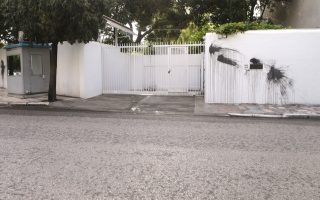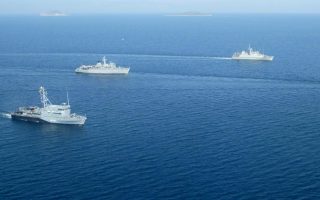The cruellest walls

On April 18, during a riot in Derry, the second city of Northern Ireland, a 29-year-old journalist, Lyra McKee, was shot dead, probably by a paramilitary republican. Her funeral brought together politicians from both sides of the political and religious divide which has caused thousands of violent deaths since 1968. At the front of the congregation were the Irish and British prime ministers. Behind them, like Siamese twins of hatred, sat the leaders of the Unionist and Republican factions, one committed to maintaining the union with Britain, the other to ending the partition of the island by incorporating Northern Ireland into the Republic.
When the officiating priest asked, “Why in God’s name does it take the death of a 29-year-old woman with her whole life in front of her to get to this point?” the congregation spontaneously gave a standing ovation. All except the politicians at the front, who, sensing the movement behind them, cautiously got to their feet, anxious to go with the crowd, even if it meant damaging their fragile profiles. For the ugly sisters of Unionism and Republicanism it was like giving your worst enemy the kiss of peace.
Reports of this tragic occasion sit on my desk beside the Booker Prize-winning novel “Milkman” by Anna Burns, recently published by Gutenberg-Dardanos as “O Galatas” in Maria Angelidou’s Greek translation. This novel, narrated by a young woman from a republican family, graphically presents the world to which Lyra McKee belonged and from which she believed she was escaping. McKee was born in exactly the type of borderline environment – Belfast’s “Murder Mile” – so pitilessly portrayed in “Milkman.” A world in which survival is impossible in any meaningful sense.
It is often said that Nicosia is the only European capital divided by a wall. But not only is Belfast (the capital of Northern Ireland) divided by the ironically named “peace walls,” but the hearts and minds of almost everyone in that province are divided by walls of religion, walls of politics, and walls of fear and hatred.
The Belfast (or “Good Friday”) Agreement of 1998, accompanied by a “cease-fire” by the majority of paramilitaries on both sides, offered the possibility that political differences could be acted out in the absence of violence. This has repeatedly proved to be illusory.
Burns is unrelenting in her depiction of the walls that not only divide republican nationalists and unionists but also cruelly hold them together in a symbiosis of fear. In Irish history, the “pale” was a boundary between the “civilized” and the “barbarians.” “Beyond the pale” signified your exclusion from civilized society. Burns uses the “beyond-the-pale” cliche to describe anyone in Northern Ireland whose behavior or conversation make them unorthodox. And almost everyone is unorthodox because even to think differently from an unspoken norm is to betray oneself and one’s tribe.
It is almost entirely “beyond the pale” to have any kind of relationship, even within one’s own family. Even the absence of body language, “numbance” as she calls it, is a useless protection. The way you walk down the street can be a betrayal of your thoughts.
Lyra McKee was “beyond the pale” in almost every sense. She was a journalist; she was optimistic; she was gay – all anathema to both sides. Born in 1990, she described herself as one of the “Cease-fire Babies, destined to witness not the horrors of war but to reap the spoils of peace.” How wrong she was. Even though her killing was probably accidental (the gunman was aiming at the police), her optimism and her refusal to take sides condemned her.
Burns’ fictional world is, of course, extreme, over-the-top. No one could live in the conditions she describes. But so convincing is her narrative, so utterly devastating is the fiction, that it becomes credible.
In Burns’ narrative, you never answer a question, because the answer will almost certainly be wrong. “In a district that thrived on suspicion, supposition and imprecision, where everything was so back-to-front it was impossible to tell a story properly, or not tell it but just remain quiet, nothing could get said or not said but it was turned into gospel.” The wrong answer will lead to kneecapping, tarring-and-feathering or, of course, death and, quite possibly, disappearance. Ironically, McKee was writing a book, “The Lost Boys,” about the “disappeared” bodies which have never been uncovered.
One thinks of C.P. Cavafy’s “Waiting for the Barbarians” – the anticipated barbarians don’t arrive. “Now what’s going to happen to us without barbarians?” the poet asks. “These people were a kind of solution.” Without someone to fear, without a threat to one’s civilization, there is no need for walls. Where would we be without walls? If we had no one to hate? The cruellest walls are those within the heart, within the psyche, dividing love from reality, sense from hope. Walls that shut down all possibility.
Readers of “O Galatas” will find many echoes of the “lies of silence” within Greek and Cypriot society. In 1970 Lawrence Durrell tried to argue that Turks and Greeks could live harmoniously in Cyprus, respecting one another’s differences, just as they do in Thrace and Rhodes and just as Catholics and Protestants, nationalists and unionists, might in Ireland. That was before the Turkish invasion of 1974 and the building of the wall in Nicosia. But that wall seems quite friendly, compared to the psychic and emotional walls of “O Galatas.”
Richard Pine was voted “Critic of the Year” in the 2018 Irish Journalism Awards. He lives and works in Corfu, and is the author of “Greece Through Irish Eyes.”




